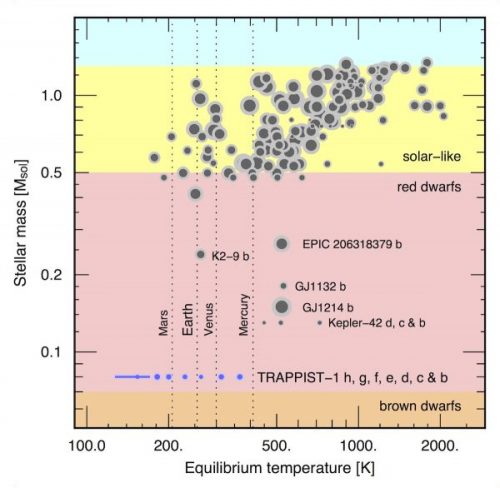April 4, 2017
On February 22, NASA announced the discovery of seven rocky planets around a nearby star. Not only is this a groundbreaking crop of new Earth-size rocky exoplanets, but the system also boasts three (three!) rocky planets with the potential to harbor life.
The TRAPPIST-1 system, named after the telescope in Chile that discovered it, is a mere 40 light-years away in the direction of the constellation Aquarius. Composed of solid rock, all seven of planets are about the size of Earth or Venus. Their parent star, called TRAPPIST-1a, is a small red dwarf that is much cooler than our sun. The planets also orbit much closer to their parent star than Earth does to the sun. In fact, the entire system could fit inside the orbit of Mercury. Because of their small orbital radii, the TRAPPIST-1 planets zip around rapidly. The innermost planet makes a complete revolution almost once a day, and the furthest planet makes the trip in less than three weeks.

This plot shows the temperature of discovered exoplanets (x-axis) in relation to the size of their parent star (y-axis). Each grey dot represents an exoplanet, with relative sizes shown by the width of each dot. The temperature of our solar system’s four terrestrial planets are shown with dotted vertical lines.
Notably, the planets TRAPPIST-1d, -1e, and -1f orbit in the “Goldilocks Zone,” a region neither too hot nor too cold to have liquid water on their surfaces. This fact has caused some to speculate whether the system could support life.
In the minds of science enthusiasts everywhere, these discoveries raised an inevitable question: could we colonize the TRAPPIST-1 system? It’s not too far away, and nanoscale solar-powered probes could make a round trip within the century, with human colonizers following in the millennium after.

